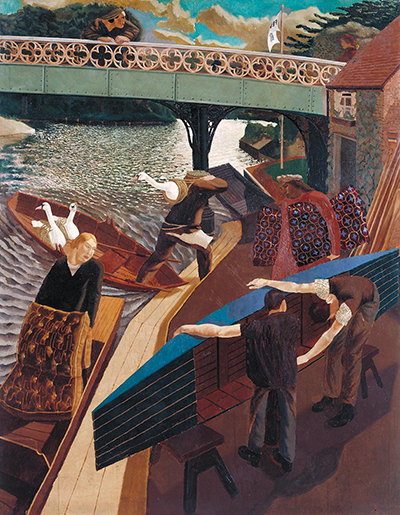Swan Upping at Cookham is an oil painting on canvas by Stanley Spencer (1891 - 1959). A Slade graduate, Spencer started the painting in 1915 although it was not completed until 1919.
The reason for the delay in completion is apparent in the dates for these are the years of the Great War. Spencer left to serve as first a medical orderly and later in the infantry in 1915. The brutal events he witnessed during the war and the death of his older brother profoundly impacted the artist. While away at war he often fantasized about his return and completing the painting, but when he did eventually return he was unsure whether he would paint again, saying that after his experiences painting would be neither sensible nor proper. Fortunately, he found solace in his art, completing Swan Upping at Cookham in 1919 and remained a prolific artist throughout his life.
Swan Upping at Cookham portrays a rural, riverside scene that stands in stark contrast to the horrors Spencer witnessed at war, which inspired some of his other works. Cookham, a village on the scenic River Thames, was Spencer's birthplace and where he frequently lived during his life. The village, its people and river is a common theme in Spencer's work, displaying the love for the place he described as "a village in Heaven".
The painting shows a scene of swan upping, a centuries-old tradition that survives to this day. Traditionally unmarked mute swans belong to the British Crown, although rights were frequently granted to landowners. During Swan Upping the swans are captured and marked before being released to ascribe ownership of those swans on the Thames. The inspiration for Swan Upping at Cookham came when Spencer was in Holy Trinity Church and could hear the people on the river. He frequently made links between religious and secular life, considering the village to contribute as much to the atmosphere of the church as the holiest parts of the building.
The painting shows the River Thames gleaming beneath a blue sky. In the foreground, just past a bridge, a number of boats can be seen. On one of the boats, two swans are bound, while a third is just being carried ashore. Other figures in the picture include two men inspecting an upturned boat and an onlooker watching from the bridge. Swan Upping at Cookham proved to be a significant painting for the artist, leading to other works of riverside and village scenes. It is currently in the collection of Tate Britain.




